Contents
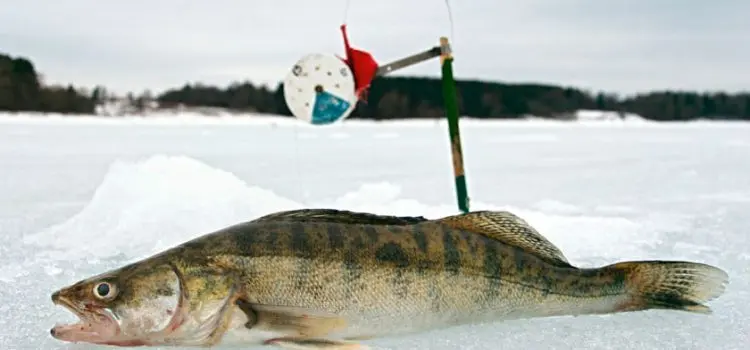
This method of fishing refers to winter fishing and involves catching large specimens of this fish. Pike perch are caught from ice in other ways, including on a balancer. At the same time, pike perches weighing no more than 1 kilogram come across, while an individual weighing up to 10 kg can be caught on a vent. You should always be ready for such surprises in order to expand the hole in time.
At the same time, anglers need to remember that pike perch, 35 cm long or less, should be released so that there is something to catch in the future.
Tackle for zander
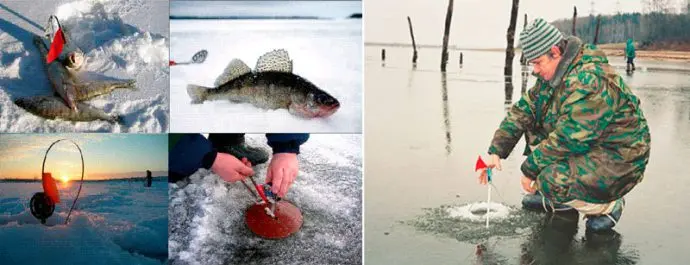
Pike perch, like all other fish, is quite cautious. Therefore, light tackle without metal leashes is used to capture it. Zander’s teeth are not as sharp as, for example, those of a pike, so he is not able to bite a leash from an ordinary fishing line. If there is a high probability of pike biting, then the leash can be put, but nylon. A metal leash can scare off pike perch. An ordinary fishing line with a diameter of 0,25-0,5 mm is taken as the main fishing line, and the same fishing line with a diameter of 0,2-0,3 mm is taken as a leash. There must be a supply of fishing line on the tackle, up to 20 meters long, but not less than 10 meters. If the zander takes the bait, he will first try to drag it to the side. If the fishing line is not enough, and it stops being bled off the reel, then the pike perch can throw the bait, sensing something suspicious.
You can use a single hook number No. 9-12 or a double number No. 6-7. In order not to scare off pike perch, it is better to give preference to a single hook. Doubles and tees are good for pike fishing.
In the case of a bite, you should not rush to strike, otherwise you can simply pull the live bait out of the predator’s mouth. But you should not delay the hooking, as the pike perch can tighten the tackle and confuse it.
When to start fishing
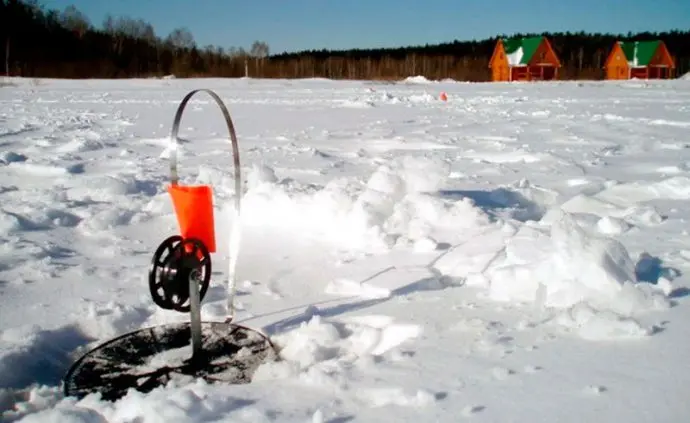
Catching pike perch on vents begins from the moment when the ice on the pond becomes thick enough and safe. This fishing continues until it becomes dangerous to go out on the ice, due to its melting. Moreover, bad weather at the height of winter does not negatively, but positively affects the biting of zander, although not always.
The period of the beginning of fishing depends on natural conditions, as well as the nature of the reservoir. The smaller the body of water, the faster it freezes. If we talk about rivers, then the presence of a current can significantly shift the timing of the start of zander fishing for a certain time. If the winter is not severe, then the river may not freeze at all. At the same time, it should be remembered that only on strong ice can one begin to install vents.
Pike perch prefers to hunt at night, so it is better to install zherlitsy at night in order to check them in the morning. Most pike bites in this case turn out to be false. This is due to the fact that at night there is no one to carry out cuttings. With a similar approach to fishing, you need to be prepared for the fact that frequent hooks or breaks are possible. He can simply pull the live bait, swimming past and throw it, sensing something was wrong. If the tackle is supplied with a leash, then the chances of catching zander are reduced to zero.
Choosing a place to fish
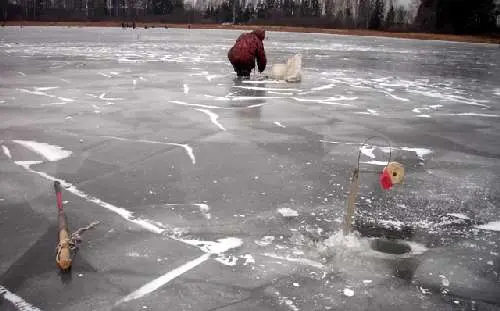
Holes can be drilled both in a checkerboard pattern and in the form of curved lines. The latter method is more efficient and allows you to quickly find pike perch. For the winter, this fish strays into flocks and stays at depth. Therefore, the use of the second method of drilling holes can bring the following results:
- First, the curved line allows for a smooth transition from shallower to deeper spots. This allows you to quickly determine the topography of the bottom, which means you can quickly find the place where the zander is located.
- Secondly, the installed girders are clearly visible, since they are not on the same line. Therefore, fixing bites is much more convenient.
Holes are punched at a distance of 10-15 m from each other. If there are no bites, you should look for another place and start drilling holes. As a rule, you won’t catch a lot of fish in one place, or you’ll even be left without a catch. Therefore, winter fishing is a constant search with constant drilling of holes. In one place, more than 2 hours should not be delayed.
During winter fishing for pike perch and other predatory fish, there are prohibitions on the number of established vents per person. Therefore, before going ice fishing, you should familiarize yourself with the rules of winter fishing that apply within the region. As a rule, the number of tackles is limited to 10 vents per angler.
Pike perch, even in summer, leads a benthic lifestyle and rarely rises to the middle layers or closer to the surface, not to mention winter. Therefore, the live bait sinks closer to the bottom and is kept at a distance of about 20 cm from the bottom itself. It does not make sense to lower it lower, since there may be surprises in the form of sticks, snags, etc. at the bottom. In such cases, hooks are possible, especially since there is a live fish on the hook, which will easily try to hide, for example, in the grass or other algae remaining at the bottom. And yet, pike perch likes to choose such places.
If the reservoir is not familiar, then it is better to spend some of the time, albeit precious, studying the bottom topography in the place of fishing. To do this, you need to take the load and measure the depth of the reservoir at the points where the holes are drilled. The presence of a sharp drop in depth will indicate the presence of a promising point. As a rule, pike perch loves places where there are holes and other depressions.
This approach almost always guarantees a catch, even if it takes most of the time. Naturally, in winter the day is quite short and you want to devote all the time to fishing and not measuring the depths of the reservoir. This approach to fishing can turn into a waste of time if you “hunt” for zander without knowing the nature of the bottom of the reservoir. To more accurately determine the depth of the reservoir at characteristic points, you need to punch holes every 2 meters. This tactic will pay off with a good catch.
Despite the fact that pike perch is a rather shy fish, it is not afraid of the noise of the drill, but rather attracts it. At least that’s what some ice fishing enthusiasts say. If the pike perch has started to be caught, there is no time to waste, because there is a flock of pike perch under the ice. You need to reload the tackle very quickly and throw it into the hole.
Many fishermen claim that catching pike perch in winter on a balancer is no less successful than catching on vents. The only thing is that the copies can be smaller.
Liver of pikeperch
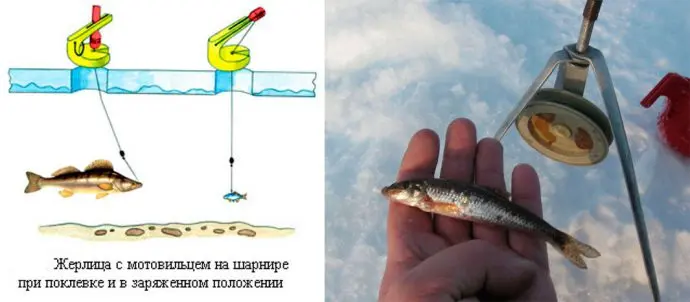
The favorite delicacy of pike perch is bleak, so pike perch is unlikely to resist such a live bait and will attack the bait. In addition to bleak, you can use other “little things”, other types of fish, such as:
- bleak.
- Roach.
- Ruff.
- The sandblaster.
- A bull.
- perch.
For catching pike perch, a rather small fish is chosen, unlike pike. The perch also bites perfectly on a small live bait. Therefore, you need to be prepared for the fact that the fisherman’s catch will be replenished with perch.
The live bait is hooked on the upper fin. Some anglers set the bait fish by threading the hook through the lower fin, after which they wind the hook over the gills and remove the stinger through the mouth. In such cases, the chances of catching zander increase.
At the same time, you should always remember that pike can also bite on live bait. As a rule, such bites end in a breakage of gear. The fact is that a pike easily bites a leash from an ordinary fishing line, and it makes no sense to put a metal leash for catching zander.
If fishing takes place on a river where there is a significant current, it is better to hook the live bait by the lip. In this state, the live bait will be active for a long time.
On the proposed video, you can see how successful the “hunt” for pike perch with the help of a zherlitsa can be.









